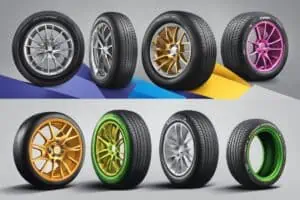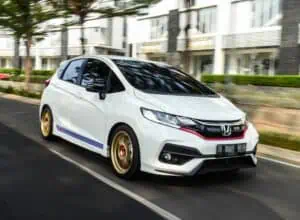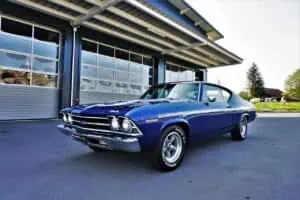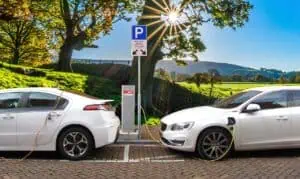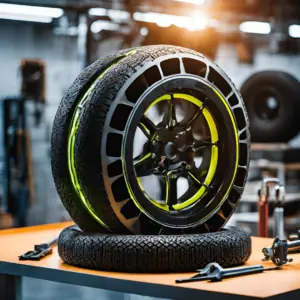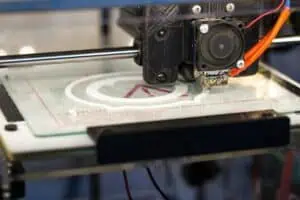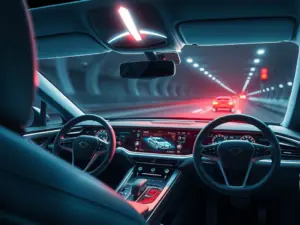Imagine cruising down the highway, your eyes fixed on the road ahead. Suddenly, a holographic arrow appears to float
just above your hood, guiding you effortlessly to your exit. As you approach a vehicle ahead, a subtle red outline
highlights its position, ensuring you maintain a safe distance. Welcome to the world of Augmented Reality (AR)
dashboards – a revolutionary technology that’s set to transform our driving experience.
The Dawn of a New Driving Era
For decades, we’ve relied on traditional instrument clusters to provide us with essential driving information. But as we
stand on the brink of a automotive revolution, AR dashboards are emerging as the next big leap in vehicle interface
design. These futuristic displays are not just a fancy add-on; they represent a fundamental shift in how we interact with
our vehicles and perceive the road around us.
From Analog to Digital: The Evolution of Vehicle Dashboards
To appreciate the magnitude of this change, let’s take a quick trip down memory lane. The first cars had minimal
instrumentation – perhaps just a fuel gauge and a speedometer. As vehicles became more complex, so did their
dashboards. The 1980s and 1990s saw the introduction of digital displays, while the 2000s brought us touchscreens and
infotainment systems.
But AR dashboards? They’re a whole new ballgame.
Decoding AR Dashboards: More Than Meets the Eye
At its core, an AR dashboard overlays digital information onto the driver’s view of the real world. This is typically
achieved through a heads-up display (HUD) projected onto the windshield or through smart glasses worn by the driver.
The result is a seamless blend of virtual data and the physical environment, creating an information-rich driving
experience that feels almost magical.
The Tech Behind the Magic
AR dashboards rely on a complex interplay of technologies:
- Sensors and Cameras: These capture real-time data about the vehicle’s surroundings.
- GPS and Navigation Systems: For accurate positioning and routing information.
- Computer Vision: To interpret the visual data and identify objects on the road.
- Projection Technology: To display the AR elements on the windshield.
- AI and Machine Learning: To process data and make split-second decisions about what information to display.
Key Features: Transforming Your Windshield into a Command Center
AR dashboards are not just about flashy graphics; they’re about enhancing every aspect of your drive. Let’s explore the
key features that are set to revolutionize our time behind the wheel.
1. Safety First: A New Level of Road Awareness
Safety is paramount in automotive design, and AR dashboards take it to a whole new level. Imagine:
- Hazard Detection: Visual alerts highlighting potential dangers, from pedestrians to road debris.
- Lane Departure Warnings: Virtual lines that light up if you drift out of your lane.
- Blind Spot Visualization: Making those tricky blind spots a thing of the past with AR overlays.
- Dynamic Speed Limits: Speed limit signs that update in real-time based on road conditions.
These features don’t just provide information; they actively enhance the driver’s awareness, potentially reducing accidents and saving lives.
2. Navigation Reimagined: Say Goodbye to Wrong Turns
Remember the days of squinting at paper maps or glancing nervously at your phone’s GPS? AR dashboards are set to make navigation intuitive and immersive:
- Floating Directional Arrows: Guiding you turn by turn, right on the road in front of you.
- Real-Time Traffic Updates: Visual representations of traffic flow and suggested alternate routes.
- Points of Interest: Highlighting gas stations, restaurants, or parking spots as you drive past.
- Enhanced Night Vision: Improving visibility in low-light conditions by outlining road edges and signs.
With these features, getting lost might become a thing of the past. The road itself becomes your navigation system, with
every turn and landmark clearly marked in your field of view.
3. Vehicle Diagnostics: Your Car Talks to You
AR dashboards bring your vehicle’s health and performance data to life:
- Real-Time Fuel Efficiency: Visual representations of your current fuel consumption and tips for improvement.
- Maintenance Alerts: AR notifications pointing to specific parts of your car that need attention.
- Battery Life for EVs: For electric vehicles, clear visualizations of remaining range and nearby charging stations.
- Tire Pressure Monitoring: AR overlays showing the status of each tire as you drive.
This immediate, visual feedback allows drivers to stay on top of their vehicle’s condition, potentially avoiding breakdowns and improving overall performance.
4. Driver Assistance: Your Co-Pilot in the Digital Age
AR dashboards work hand-in-hand with advanced driver assistance systems (ADAS) to create a safer, more efficient
driving experience:
- Adaptive Cruise Control Visualization: See the distance to the car ahead and your vehicle’s planned adjustments.
- Parking Assistance: AR overlays guiding you into tight spots with precision.
- Collision Avoidance: Visual and auditory warnings when the system detects an imminent collision.
- Road Sign Recognition: Important signs highlighted and explained in your field of view.
These features act like a knowledgeable co-driver, always alert and ready to assist you in any situation.
5. Entertainment and Connectivity: Staying Informed and Entertained
While safety is crucial, AR dashboards also enhance the entertainment and connectivity aspects of driving:
- Hands-Free Calling: Caller information displayed without taking your eyes off the road.
- Music Controls: Album art and playback controls subtly integrated into your view.
- Social Media Updates: (Customizable) Important notifications displayed safely in your peripheral vision.
- Augmented Points of Interest: Information about landmarks, restaurants, or historical sites as you drive by.
These features keep you connected and entertained while minimizing distractions – a crucial balance in our always connected world.
The Road Ahead: Challenges and Future Predictions
While the potential of AR dashboards is enormous, the road to widespread adoption is not without its bumps. Let’s look at some challenges and what we might expect in the coming years.
Overcoming the Hurdles
- Cost Concerns: Currently, AR dashboard technology is expensive, limiting it to high-end vehicles. However, as
with most tech, prices are expected to decrease as adoption increases. - Driver Distraction: There’s a fine line between helpful information and information overload. Designers must
carefully balance the amount and type of data displayed to prevent distraction. - Technical Limitations: Ensuring the AR system works flawlessly in all weather conditions and lighting situations
remains a challenge. - Regulatory Hurdles: As with any new automotive technology, AR dashboards must meet strict safety regulations,
which can slow down implementation. - Privacy Issues: The data collected by AR systems raises questions about user privacy and data security.
Looking to the Future: 2025 and Beyond
Despite these challenges, the future looks bright for AR dashboards. Here’s what we might expect:
By 2025: We’ll likely see AR dashboards become standard in luxury vehicles and optional in mid-range cars. The technology will focus primarily on safety features and basic navigation.
2030 and Beyond: AR dashboards could become as common as touchscreens are today. We may see:
- Full windshield displays with touch-interactive elements
- Integration with smart city infrastructure for real-time traffic management
- Advanced AI that learns driver preferences and adjusts displays accordingly
- Seamless connection with smart homes and workplaces, turning your car into a mobile extension of these spaces
AR Dashboards vs. Traditional Dashboards: A New Era of Driving
As we look to the future, it’s natural to wonder: are AR dashboards really necessary?
| Feature: | Traditional Dashboard | AR Dashboard |
| Information Display | Fixed, Limited space | Dynamic, uses entire windshield |
| Real-time Environment Integration | Limited | Extensive |
| Customization | Minimal | Highly customizable |
| Driver Focus | Requires looking away from road | Keep eyes on road |
| Maintenance Information | Basic warning lights | Detailed, visual diagnostics |
| Navigation | Separate screen | Integrated with real-world view |
| Safety Features | Passive warnings | Active, predictive alerts |
While traditional dashboards have served us well, AR dashboards offer a level of integration and real-time information
that was previously impossible. They don’t just display data; they interpret it and present it in the most useful way
possible.
The Impact on Different Stakeholders
The rise of AR dashboards will have far-reaching effects across various groups:
Automotive Enthusiasts: A new frontier of vehicle customization and performance monitoring.
Technology Professionals: Opportunities for innovation in software development, AI, and user interface design.
General Consumers: Enhanced safety and a more intuitive, enjoyable driving experience.
Transportation Policymakers: New considerations for road safety regulations and driver licensing.
Car Manufacturers: A new battleground for competitive advantage and brand differentiation.
Cautious Augmented Road Ahead
As we stand on the brink of this automotive revolution, one thing is clear: AR dashboards are set to redefine our
relationship with our vehicles and the road itself. They promise a future where driving is safer, more intuitive, and more
connected than ever before.
While challenges remain, the potential benefits – from enhanced safety to a more enjoyable driving experience – are too
significant to ignore. As the technology matures and becomes more accessible, we can expect to see AR dashboards
transform from a luxury feature to a standard expectation.
The future of driving is here, and it’s being projected right onto our windshields. Get your wallets ready, because the ride is about to get a whole lot more interesting, for better or worse.








